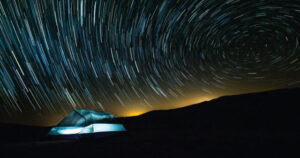Martian gullies as seen in the top image from HiRISE on NASA's Mars Reconnaissance Orbiter resemble gullies on Earth that are carved by liquid water. Credit: NASA/JPL-Caltech/UA/JHUAPL
New findings using data from NASA's Mars Reconnaissance Orbiter show that gullies on...
The blue dots in this field of galaxies, known as the COSMOS field, show galaxies that contain supermassive black holes emitting high-energy X-rays.Credits: NASA/JPL-Caltech
Supermassive black holes in the universe are like a raucous choir singing in the language of...
Magnetic fields on the Sun and stars like it are responsible for much of their behavior, including the generation of powerful storms that can produce spectacular auroras on Earth, damage electrical power systems, knock out communications satellites, and affect...
The stars circled in blue are ones identified by the US Naval Observatory B-1.0 catalog.Credit: Image courtesy of Texas Tech University
Alone on the cosmic road, far from any known celestial object, a young, independent star is going through a...
This artist's impression shows the strange object AR Scorpii. In this unique double star a rapidly spinning white dwarf star (right) powers electrons up to almost the speed of light. These high energy particles release blasts of radiation that...
Turbulent atmospheric flows above the storm produce both gravity waves and acoustic waves. Gravity waves are much like how a guitar string moves when plucked, while acoustic waves are compressions of the air (sound waves!). Heating in the upper...
Binary black holes recently discovered by the LIGO-Virgo collaboration could be primordial entities that formed just after the Big Bang. Primordial black hole binaries were discussed extensively in the 1990s; however, interest in them waned when observations implied that...
This graph shows the evolution of the apparent brigntness of the new supernova it is shown according to data collected by the Dark Energy Survey. It can be seen how an initial increase in brightness occurs which is then...
Scientists with NASA's Dawn mission were surprised to find that Ceres has no clear signs of truly giant impact basins. This image shows both visible (left) and topographic (right) mapping data from Dawn. Credit: NASA/JPL-Caltech/SwRI
When NASA's Dawn spacecraft arrived...
Image Courtesy of SwRI/Simone Marchi. The top of this false-color image includes a grazing view of Kerwan, Ceres’ largest impact crater. This well-preserved crater is 280 km (175 miles) wide and is well defined with red-yellow high-elevation rims and...
This is a view of the jets of the elliptical galaxy in Cygnus A.Credit: X-ray image: NASA/CXC/SAO; visible light image: NASA/STScI; radio waves image: NSF/NRAO/AUI/VLA.
Cygnus A is an elliptical galaxy at around 600 million light years from the Earth,...
























